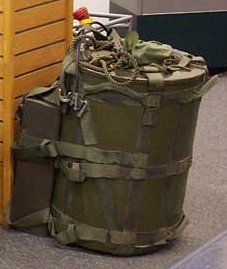Special Atomic Demolition Munition

The Special Atomic Demolition Munition (SADM) was a family of man-portable nuclear weapons fielded by the US military in the 1960s, but never used in actual combat. The US Army planned to use the weapons in Europe in the event of a Soviet invasion. US Army Engineers would use the weapon to irradiate, destroy, and deny key routes of communication through limited terrain such as the Fulda Gap. Troops were trained to parachute into Soviet occupied western Europe with the SADM and destroy power plants, bridges, and dams.
The project, which involved a small nuclear weapon, was designed to allow one person to parachute from any type of aircraft carrying the weapon package and place it in a harbor or other strategic location that could be accessed from the sea. Another parachutist without a weapon package would follow the first to provide support as needed.
The two-person team would place the weapon package in the target location, set the timer, and swim out into the ocean where they would be retrieved by a submarine or a high-speed surface water craft.
In the 1950s and 1960s, the United States developed several different types of lightweight nuclear devices. The main one was the W54, a cylinder 40 by 60 cm that weighed 68 kg. It was fired by a mechanical timer and had a variable yield equivalent to between 10 tons and 1 kiloton of TNT. The W54 nuclear device was used in the Davy Crockett Weapon System.
